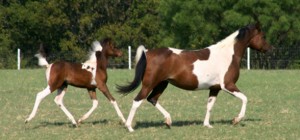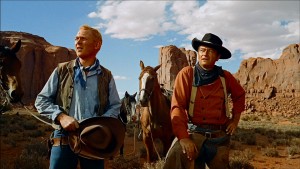“Oh NO says Coyote … The Pinto was sitting in a low depression …” (122-130)
Green Grass Running Water is a novel full of allusions, the following are allusions I have researched from pages 122 to 130.
Noah and Changing Woman
Changing Woman encounters Noah’s ark, or “big canoe” (King) in this case, and is determined not to land in all of the “poop” (King) created by the myriad animals on board. The Noah we encounter appears savage, unlike any of the Islamic, Biblical, or literary references I have encountered before. According to Flick the words “big canoe” are a mockery of ” missionary adaptations of biblical stories for Indians” (Flick 152).
Noah, in this narrative, equates talking to animals to “bestiality” and wants Changing Woman to show him her breasts. Noah’s admonishments to Changing Woman regarding her talking to animals appears to be symbolic of colonizers who attempt to convert people as well: Noah keeps using the argument of “Christian rules” when speaking with Changing Woman. King uses this Biblical reference and shows Noah as a man who assumes that since Changing Woman fell from the sky she must be a “gift from heaven” (King) and proceeds to treat her like property he has no right over – perhaps this allusion is a reference to the fact that when white settlers landed in North America they chose to just take or presume that all land they had landed they had in fact conquered and therefore it belonged to them: even though the land had people living them from before and clearly belonged to someone else.
According to Laura E. Donaldson this use of the Noah story is also a
” kind of poetic justice, since early Euramerican accounts positioned Native Americans as descendants of Noah’s disgraced and exiled son, Ham. For the seventeenth-century Puritans, such a paternal heritage allowed them to ask whether the Indian “was not perhaps the farthest of all God’s human creatures from God Himself? Descended from wander ers, had he not lost his sense of civilization and law and order? Had he not lost, except for a dim recollection, God Himself?” (Pearce 25). ” (Donaldson, 29)
Thus using this as a backdrop for the Noah story in this novel it is evident that the tables are being turned on him. Donaldson also references the idea of the Christian belief that “women bear primary responsibility for the Fall.” (Donaldson, 34).
The Pinto
As Charlie arrives in Blossom he rents a car and ends up with a rickety red Pinto. The car plays a strange role in the novel as it is one of the cars which ends up in the dam. The car is made by Ford, a quintessential American car brand. According to Jane Flick a Pinto can also refer to a “Plains horse”, or a “piebald or “painted” pony associated with Indians of the Plains”. Pinto is more specifically a horse coloring, considered “the proper breed” in America. A Pinto horse has a dark background coloring with large, and random, splashes of white. Considering the fact that this car is associated with the destruction of the dam, an area warred over by Eli and a white building company, the coloring aspect of its name and the fact that King chose this car could either be a strange coincidence or King chose it on purpose – the horse itself depicts a colored background with large patches of white coloring.
According to HorseChannel.com “spotted horses seem to have originated with American Indian horses, the distinctive two-toned coat pattern probably came to North America through Arabian and Spanish stock that accompanied early explorers. Early American Indians preferred the spotted color and bred horses specifically for this characteristic.” thus making these horses, and this distinctive coloring, all the more poignant for a story where Indigenous people are being harassed – whether through Amos’ experience with border officials or through the stolen truck incident – this word, and by extension this car that Charlie drives, becomes symbolic of the divide, harassment, and colonization of the Indigenous peoples.
Charlie’s Father: Portland Looking Bear/Iron Eyes Screeching Eagle
Throughout the novel Charlie is recognized and mistaken for his father, people constantly ask him why he appears familiar and comment on having seen him before, this is due to the fact that his father appeared as the quintessential ‘Indian’ in Hollywood Westerns. (Later in the novel a Western film is ‘fixed’ by the four Old Indians and Charlie’s father, unusually for Westerns of the time, defeats the Cowboys.). According to Flick Portland Looking Bear’s stage name, Iron Eyes Screeching Eagle is a “joke about choosing a “really Indian” name for the movies.” (Flick, 153).
According to the AMC Filmsite, Westerns plots were simple and consisted usually of one main theme
“the classic, simple goal of maintaining law and order on the frontier in a fast-paced action story. It is normally rooted in archetypal conflict – good vs. bad, virtue vs. evil, white hat vs. black hat, man vs. man, new arrivals vs. Native Americans (inhumanely portrayed as savage Indians), settlers vs. Indians, humanity vs. nature, civilization vs. wilderness or lawlessness, schoolteachers vs. saloon dance-hall girls, villains vs. heroes, lawman or sheriff vs. gunslinger, social law and order vs. anarchy, the rugged individualist vs. the community, the cultivated East vs. West, settler vs. nomad, and farmer vs. industrialist to name a few. Often the hero of a western meets his opposite “double,” a mirror of his own evil side that he has to destroy.”
A young Charlie asks his mother whether his father played a myriad of roles and is told by his mother, Lillian, that his father “made a very good Indian” (King). Portland Looking Bear fulfilled Hollywood’s demand for the stereotypical Indian, the ‘Hollywood Indian’, and we are thus led into the racist world of Hollywood where actors were paid less than “their white counterparts” (Tavare) and were forced to wear prosthetic noses in order to look even more like the stereotypical Indian. All of this led to the idea that “all Indians are the same” (Flick 153) an idea which King emphasizes through the Westerns talked about and shown throughout the novel.
Works Cited
“Breeds of Livestock, Department of Animal Science.” Breeds of Livestock. Oklahoma State University Board of Regents, 28 May 1996. Web. 15 Aug. 2015.
Dirks, Tim. “Westerns Films.” Filmsite. American Movie Classics Company LLC, n.d. Web. 15 Aug. 2015.
Donaldson, Laura E. “Noah Meets Old Coyote, or Singing in the Rain: Intertextuality in Thomas King’s Green Grass, Running Water.”Studies in American Indian Literatures 7.2 (1995): 27-43. JSTOR. Web. 15 Aug. 2015.
Flick, Jane. “Reading Notes for Thomas King’s Green Grass, Running Water.” Canadian Literature 161-162.161/162 (1999): 140.
“Pinto Horses.” Pinto Horses. HorseChannel.com, n.d. Web. 15 Aug. 2015.
Sutor, Cheryl. “Equusite.com – Coat Colors and Patterns: Paint and Pinto Horse Color.” Equusite.com. Cheryl McNamee-Sutor, Jan. 2000. Web. 15 Aug. 2015.
Tavare, Jay. “Hollywood Indians.” The Huffington Post. TheHuffingtonPost.com, 18 May 2011. Web. 15 Aug. 2015.


